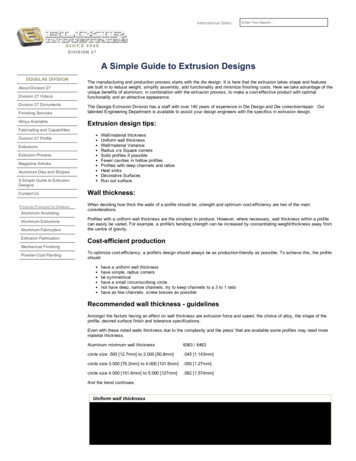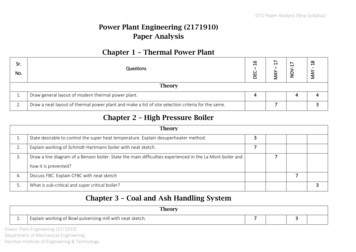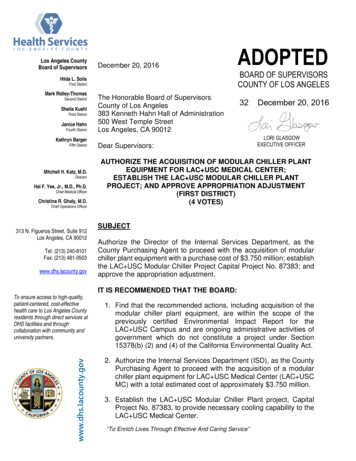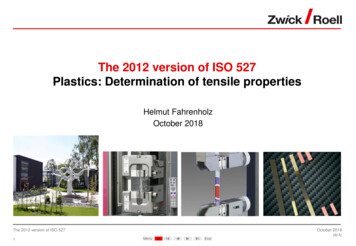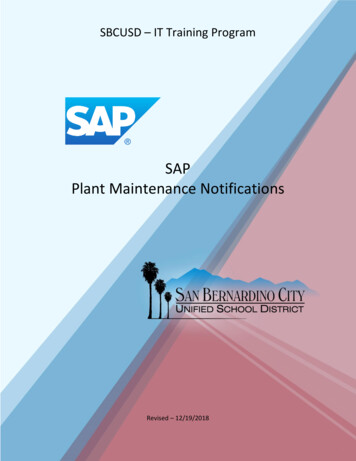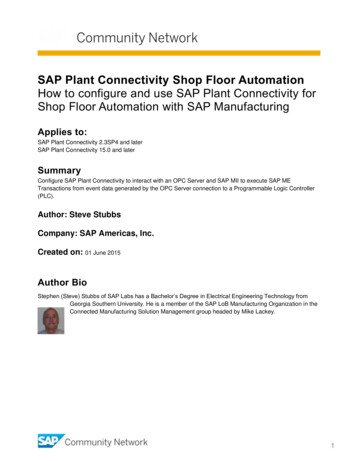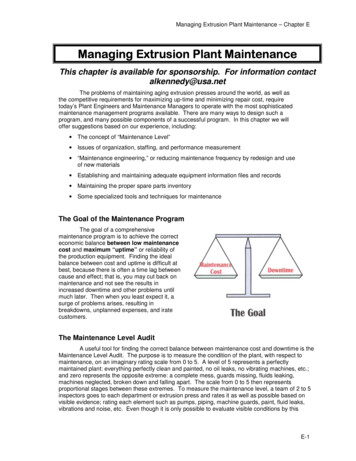
Transcription
Managing Extrusion Plant Maintenance – Chapter EManaging Extrusion Plant MaintenanceThis chapter is available for sponsorship. For information contactalkennedy@usa.netThe problems of maintaining aging extrusion presses around the world, as well asthe competitive requirements for maximizing up-time and minimizing repair cost, requiretoday’s Plant Engineers and Maintenance Managers to operate with the most sophisticatedmaintenance management programs available. There are many ways to design such aprogram, and many possible components of a successful program. In this chapter we willoffer suggestions based on our experience, including: The concept of “Maintenance Level” Issues of organization, staffing, and performance measurement “Maintenance engineering,” or reducing maintenance frequency by redesign and useof new materials Establishing and maintaining adequate equipment information files and records Maintaining the proper spare parts inventory Some specialized tools and techniques for maintenanceThe Goal of the Maintenance ProgramThe goal of a comprehensivemaintenance program is to achieve the correcteconomic balance between low maintenancecost and maximum “uptime” or reliability ofthe production equipment. Finding the idealbalance between cost and uptime is difficult atbest, because there is often a time lag betweencause and effect; that is, you may cut back onmaintenance and not see the results inincreased downtime and other problems untilmuch later. Then when you least expect it, asurge of problems arises, resulting inbreakdowns, unplanned expenses, and iratecustomers.The Maintenance Level AuditA useful tool for finding the correct balance between maintenance cost and downtime is theMaintenance Level Audit. The purpose is to measure the condition of the plant, with respect tomaintenance, on an imaginary rating scale from 0 to 5. A level of 5 represents a perfectlymaintained plant: everything perfectly clean and painted, no oil leaks, no vibrating machines, etc.;and zero represents the opposite extreme: a complete mess, guards missing, fluids leaking,machines neglected, broken down and falling apart. The scale from 0 to 5 then representsproportional stages between these extremes. To measure the maintenance level, a team of 2 to 5inspectors goes to each department or extrusion press and rates it as well as possible based onvisible evidence; rating each element such as pumps, piping, machine guards, paint, fluid leaks,vibrations and noise, etc. Even though it is only possible to evaluate visible conditions by thisE-1
Managing Extrusion Plant Maintenance – Chapter Emethod, the results are in fact a remarkably good picture of the entire maintenance level, includingdowntime and repair costs.Now, with the concept of ameasurable maintenance level in mind,it becomes easier to discuss thephilosophy of the maintenanceprogram. To illustrate, let us imagine aplant with a maintenance level of 1.0.There we might see such things asvisible oil leaks, rags, and dirt, whichwill eventually result in a contaminatedhydraulic system, dirty filters, pump andvalve failures, and press downtime.What could have been repaired early fora few dollars now costs thousands,including major breakdown time. Amaintenance level at the low end of thescale may indicate a short-sighted andcostly maintenance program.At the other extreme, it is alsopossible to over-maintain a plant, forexample by excessive painting,cleaning and polishing. Once a certainlevel is reached, additional inspecting, polishing and cleaning may add little to reliability. Now, thiswriter has visited some 115 extrusion plants and has never seen a 5 (and very few 4’s). Even so, itwould seem wasteful to maintain the plant at level above 4. One would never maintain an extrusionpress to the level of a boiler room or perhaps a fire truck, where there are workers available withextra time to clean and polish the equipment.So the ideal level of maintenance seems to be in the range from 2.5 to 3.5, with smallproblems being spotted and corrected early before they become big, costly problems; and whereverpossible erring on the side of doing more than the minimum, not less. This seems to be the levelthat corresponds to maximum uptime while minimizing the cost.When trying to reduce maintenance costs, always keep in mind that a cost saving is not realif the maintenance level is lowered in the process. A good maintenance level is like money in thebank, and allowing maintenance level to decline is like using up the money that was invested for thefuture. Of course in times of extreme production demands or financial crisis, it may be necessary tosomewhat neglect maintenance. The level might be allowed to decline to, say, 2.0; but it shouldnever be allowed to get too low or else recovery will be extremely difficult and expensive. Andallowing a decline in the maintenance level must never be considered anything but temporary; afterall, it is not a cost saving, but a deferral of costs, a borrowing from the future; and the plant musteventually be returned to the economical range 2.5 to 3.5.The Maintenance Level Audit is conducted by a team of 2 to 5 persons, who come fromdifferent backgrounds and departments, and from different plants if possible. Use a checklist similarto Figure E-1 (develop your own if possible). Each team member grades each item and the resultsare averaged. Collecting this data on a quarterly or semi-annual basis will provide a useful ongoingmeasure of maintenance performance.E-2
Managing Extrusion Plant Maintenance – Chapter EFigure E-1:Maintenance Level Audit (Sample Form)Date Audited ByLocationNote: Grade each item on a scale of O (Worst) to 5 (Best)Item Department Press 1Press 2Press 3HousekeepingFloors, walkways, & laddersMechanical Equipment:Functions smoothlyVibrationLubricationHydraulic Systems:Oil leaksShock or hammerTemperature controlElectrical Equipment:Control cabinetsConduit & wiringLightingSafety Equipment:GuardsProtective equipmentPiping Systems:HydraulicCompressed airWaterOtherHeating EquipmentE-3
Managing Extrusion Plant Maintenance – Chapter EStaffing and Required SkillsPerhaps the major responsibility of maintenance management is providing the correctstaffing to meet the needs of the plant – the right number of people with the proper skills at the righttime.In extrusion plants we generally find an average staffing level in the range of 200 to 400maintenance man-hours per press per month. This figure includes direct hours worked on the pressline alone (not including equipment in the foundry, finishing, or packing areas), and it variesaccording to many factors, for example: age of the equipment size of the press design and complexity of the equipment skill level of maintenance workers whether preventive or breakdown maintenance is followed use of press operators and/or outside contractors for some workSome months there will be peaks where somewhat more man-hours are required, but onaverage the indicated range should be expected.Most extrusion plants have a continuing problem in finding and keeping maintenanceworkers with the necessary skills. Working conditions are often brutal – hot, dirty, and stressful.The best solution is to focus on improving working conditions: not only pay and benefits, but alsothe work environment and the way the work is performed. Try scheduling maintenance shut-downsduring mid-week, when parts suppliers are open and vendors are available for technical support.Your workers will thank you. By moving away from reactive to proactive maintenance, you willimprove working conditions and save money for the company at the same time.A good source for maintenance workers that is often overlooked is the press crew.Consider the advantages of moving press operators into maintenance: they already know theequipment, they are comfortable with the plant environment, and their loyalty to the company hasbeen demonstrated. They only need to be trained in the necessary skills.There are several resources for obtaining training for extrusion plant maintenance workers: the Aluminum Extruders Council offers Press Maintenance Seminars to its members every2 or 3 years vendors such as Oilgear and Allen Bradley offer specialized training on their equipment maintenance seminars or in-house training are occasionally offered by consultantsThese resources will complement the courses available at local technical schools.E-4
Managing Extrusion Plant Maintenance – Chapter EPerformance MeasurementFor the sake of measuring performance, it is useful to track the following data on at least amonthly basis for each press (in multi-press plants): maintenance man-hours percent overtime for maintenance workers hours minutes of press downtime for planned maintenance hours minutes of press downtime for breakdowns (unplanned maintenance) maintenance costsOne goal is to minimize the downtime for breakdowns, in favor of planned maintenance.Another goal is to hold maintenance overtime to less than 20% over any extended period --- morethan 20% overtime over an extended period is uneconomical and inefficient, as workers’ productivitywill likely suffer due to fatigue.Workload Planning and SchedulingIt is generally agreed that maintenance performed on a planned basis is more efficient thanwaiting until a breakdown occurs. Planned or “preventive” maintenance can be done while thepress operating crew is off duty to save costs, and without interruption of production plans. Equallyimportant, a planned shutdown makes it possible to have all the right workers on hand, and anyspecialized tools, parts, and materials available, so that the work can be done in the most efficientmanner without having to go look for tools and parts. Good planning takes time, so the office staffmust be large enough and knowledgeable about the work, in order to plan and schedule theresources needed and to coordinate the plans with the production schedule.Responsibility for maintenance planning must be assigned. A qualified staff person shouldbe put in charge of planning, since line supervisors often lack the time for detailed advanceplanning, particularly for complex shut-downs.Maintenance EngineeringMost plants, regardless of age or design, will profit from an activity which we callMaintenance Engineering (although it sometimes goes by other names as well). It is the reductionof maintenance costs and downtime by finding engineering solutions for recurring problems. Theproblems to be solved are identified from records of cost, downtime, and repair histories, and fromthe recommendations of production and maintenance workers. A regular Pareto analysis ofdowntime --- that is, summarizing downtime for each component of the press line --- is the correctway to identify priority items for maintenance engineering.To some extent, all maintenance and even production workers should be involved inMaintenance Engineering, and they should be encouraged to identify problems and offer solutionswherever possible. However, in larger, older plants, it is usually justified to assign one or more fulltime engineers to the activity, due to the technical skills needed and the number of opportunities forcost reduction. In any case, Maintenance Engineering should be a formal program, with regularmanagement reports that list the problems, priorities, potential savings, and the name of the personresponsible for each item.Many solutions to maintenance problems will be found in new materials and technologies inthe marketplace, so the Purchasing department should also be involved in contacting vendors andfinding sources of new technology.E-5
Managing Extrusion Plant Maintenance – Chapter EEquipment Information Files and HistoryGood maintenance requires that workers have access to suitable information about theequipment --- drawings, inspection and repair procedures, and parts lists. However, in most plantsthe lack of necessary information is a recurring problem: there is nothing in the files to helpdiagnose a problem or to explain the correct repair procedures. There are two problems here:either the correct information was never received, or it has been lost over the years.When new equipment is purchased, it is important to obtain suitable original vendorinformation, with enough copies to provide a back-up. For this reason we recommend use of aVendor Information Requirements sheet, as in Figure E-2. This form will be included with thePurchase Order for equipment any time new equipment is purchased, and it should be made a partof the Purchase Order. Note that the form lets you specify media copies --- that is, drawings in CADformat and manuals as word processor files. If available, these formats will protect against loss andallow you to make fresh copies as needed.Once the information is received, it should be distributed (usually copies to Production,Maintenance, and Engineering) and also properly archived to insure against loss over the years. By“archives” we mean a separate, locked, fire-proof file in a separate location. Recent developmentsin Personal Computer technology make it easier to create archives on magnetic media, but a “hardcopy” archive is still recommended, with access permitted only to make copies, never to remove theoriginal document from the archives. (We have seen too many plants that have lost all the drawingsand other documents of key equipment, and these plants often pay dearly for the lack ofinformation, or pay to obtain replacement documents.)What can be done in an older plant after the original information has been lost? There is noeasy answer. You must to first set up a proper information file system and an archive, starting from“zero” by listing each piece of equipment and creating a file folder for each. Next you must to go outto the equipment and record any nameplate data, and then contact the original manufacturer torequest copies of any information still available. In some cases it i
Maintenance Engineering (although it sometimes goes by other names as well). It is the reduction of maintenance costs and downtime by finding engineering solutions for recurring problems. The problems to be solved are identified from records of cost, downtime, and repair histories, and from the recommendations of production and maintenance workers. A regular Pareto analysis of

